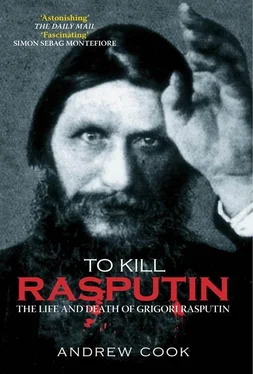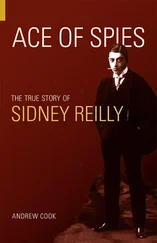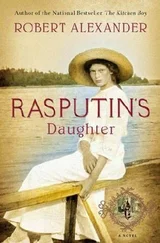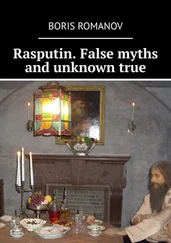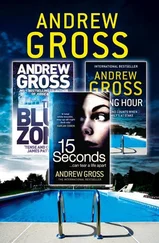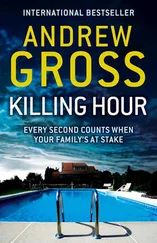After this they continued the journey in silence, enjoying the icy air blowing through the open windows, with Purishkevich silently daydreaming about the time when Grand Duke Nikolai Mikhailovich had summoned him to hear about his, the Grand Duke’s, anxiety about Rasputin and how it had been expressed to the Tsar.
This unlikely digression over, Purishkevich found himself still in the car, the corpse soft ‘at my feet’, and outside the city on a bumpy road. At last, Dmitri Pavlovich drove onto the bridge and coasted to a halt. They saw a sentry-box on the far side before the headlamps were extinguished. (The photograph taken on Monday 19 December shows that there were gas-lights at intervals on either side of the Petrovski Bridge.) Purishkevich was first out of the car and the soldier and Dr Lazovert and Captain Sukhotin helped him swing the corpse and fling it into the ice-hole (a drop of about five metres, to judge from photographs). Dmitri Pavlovich stood guard by the car.
Then they remembered they’d forgotten the weights, and dropped them after it; and weighted the coat with chains and hoisted that over as well. Dr Lazovert found one of the galoshes and threw it off the bridge. Then they drove across the bridge, and saw the sentry asleep, and returned by a route that would take them past the St Peter and St Paul Fortress. It wasn’t an easy journey; the car kept stopping, the engine misfiring, and ‘each time… Dr Lazovert jumped out, fiddled with the spark plugs, cleaned them, and somehow or other got us going again’. Despite all this, on the way back Purishkevich found time belatedly to express his doubts about the method of disposal to Dmitri Pavlovich. He hoped the body would be found, he pointed out, because otherwise ‘false Rasputins’ would appear; they should have left it somewhere conspicuous.
The last repair stop was almost opposite the St Peter and St Paul Fortress itself. After this, they bowled along without mishap to the Sergei Palace. On alighting from the motor, they found the other galosh and some bloodstains on the car’s carpet. Dmitri Pavlovich’s servant, ‘who had met us on the steps and who struck me as having been initiated into the whole affair’, was ordered to burn the carpet and the galosh. Then Lazovert, Sukhotin and Purishkevich took their leave. They took two cabs to the Warsaw Station where their womenfolk awaited – including Mrs Sukhotin, who had also spent the night on the hospital train. It was after five o’clock in the morning when they got back, and all aboard the train were asleep, except for Mrs Purishkevich.
We return to the story from Yusupov’s point of view. We left him in the courtyard with Rasputin’s body, aware that people were approaching. They were his two servants from the house, and a policeman. He stood to block the policeman’s view of Rasputin as the officer asked what was going on. He explained that the noise had been mere drunken revelry, and led him to the gates. When he returned, his servants ‘stood there. Purishkevich had told them to carry the body into the house’. Rasputin was lying differently in the snow and Yusupov was terrified; thinking the man was still alive, he went indoors, calling for Purishkevich, and then into his dressing-room for water. Purishkevich came in and saved him from swooning, and took him to the study.
While they were there, Yusupov’s servant came in and said the policeman was back; shots had been heard at the district police station, and he was being asked to tell his superior officer what he knew on the phone.
It was up to Yusupov and Purishkevich to persuade the man to keep his mouth shut. They had him brought in. Out of the blue, Purishkevich excitedly declared that Rasputin had been murdered. ‘I was horror-stricken at this conversation, but it was quite impossible to intervene and put an end to it.’Afterwards, Feeling ill, Yusupov left the study with his truncheon and saw the body below on the landing, pouring with blood. Like Purishkevich, Yusupov was overtaken by an irresistible, inexplicable impulse: this time, to batter the corpse to smithereens.
At that moment all laws of God and man were set at naught. Purishkevich subsequently told me that it was such a harrowing sight that he would never be able to forget it.
After this, he fainted, and the others went off with the body.
When he came to, he told his servant to take a dog to one of the outbuildings and shoot it. ‘He then dragged its body over Rasputin’s trail, so as to frustrate any subsequent blood analysis, and threw it on the snow-mound where not so long before the dead starets had lain.’
Yusupov gathered his servants together and swore them to silence, and set off at around five o’clock in the morning for Grand Duke Alexander Mikhailovich’s, where Fyodor, his young brother-in-law, was waiting up for him. He said he would explain everything in the morning; and ‘I went to bed and fell into a deep sleep’.
We therefore have two ‘first-hand’ accounts of the night in question; two accounts which contain a substantial number of major and important inconsistencies, to such a degree that it is impossible to reconcile the two accounts. For example:
Yusupov says that Dmitri Pavlovich and the other three conspirators arrived together at the palace, 8while Purishkevich says that he and Lazovert arrived together – Dmitri Pavlovich was already there. 9
Yusupov says that the chocolate cream cakes were poisoned, 10while Purishkevich says the pink ones were. 11
Yusupov says he played the guitar for Rasputin, 12but Purishkevich makes no reference to this at all.
Yusupov says he left Rasputin only once in order to go upstairs to the study, 13while Purishkevich says he came up to three times. 14
After Rasputin had taken several glasses of wine and eaten some of the cakes, Yusupov says he had an ‘irritated throat’, 15while Purishkevich says there was ‘constant belching and hypersalivation’. 16
Purishkevich says that, while in the study, Lazovert began feeling unwell and went downstairs to go outside. When he returned to the study he looked very ill and told the others that although he had fainted outside, the cold snow had revived him. 17Yusupov makes no mention of Lazovert coming down the stairs or returning afterwards.
Yusupov says that when he returned to his fellow conspirators in the study he was handed a gun by Dmitri Pavlovich, 18while Purishkevich says that Yusupov returned to the room and took his own ‘small Browning’ from the desk drawer in the study. 19It should also be recalled that, in his June 1917 version of the story, Yusupov states that he was given the gun by Purishkevich.
After Yusupov had shot Rasputin and the others had gone down to see the body, Yusupov says that he turned off the electric light and locked the dining room door. 20Purishkevich says that they switched the light off but left the door open. 21
Purishkevich says that after he shot Rasputin in the courtyard he stood by the body for several minutes – Yusupov was not there. 22In Yusupov’s account he is standing there with Purishkevich. 23
Yusupov was to deviate further from his 1927 account when he gave evidence, under oath, in two libel cases he initiated in 1934 and 1965. In the 1934 trial at the High Court in London, he claimed that Rasputin was still alive when he beat him with the truncheon. In his 1927 book, this happened after Rasputin was dead. In 1965, in a similar case in New York State Supreme Court, Yusupov claimed that not only had he fired the first shot, but had also fired the second shot, which in the book he attributes to Purishkevich. 24
In addition to the conflicting written accounts of Yusupov and Purishkevich, the 1923 account of Dr Stanislaus Lazovert, ‘The Assassination of Rasputin’, adds further seeds of doubt and incongruence:
Читать дальше
